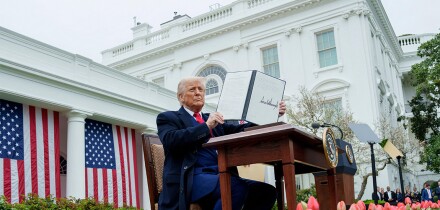Currency overlay has grown in popularity during recent years. From being an obscure and slightly risqué product it has come to be an important weapon in the institutional hedgers' arsenal. However, there is still a degree of confusion as to the precise nature of overlay, and in particular it is easily confused with currency funds, or the use of currency as an asset class.
Currency overlay is a form of hedging, pure and simple. An investor with overseas assets is exposed to currency risk, which is not negligible. In a day, a major exchange rate like U.S. dollar/Japanese yen can swing by as much as 10%. In a year, a currency can plummet to a fraction of its former value. These value changes are just as significant as any overseas asset depreciation or gain.
* To avoid volatility of this sort, investors have several
choices. We lay some of the more common ones out below:
* Do nothing: hope that negative currency movements will be
offset by positive asset value changes
* Hedge with FX forwards, locking in an exchange rate close
to current spot levels
* Hedge with FX options, allowing potential gains from FX
movement but insuring against losses
* Actively hedge, so that FX gains are realised but FX losses
are prevented.
The first, doing nothing, has proved the undoing of more than one large institution. There are various claims made for the degree of correlation between asset value and currency movements, but these tend to be founded on simplistic analysis and incorrect assumptions. In actuality correlation structures between asset value and FX rates are complex and time dependent, and offer no guarantees to the investor. Forward FX hedging can be relied upon to remove all FX volatility, which is often desirable, but does mean that there is no possibility of profiting from the FX exposure. Hedging with options allows the possibility of gains while preventing losses, but at the cost of the option premium. Active hedging holds the promise of option-like performance, but without the premium cost. However, this kind of P/L profile is only achieved by the best active hedging, with poor performers doing rather worse.
Currency overlay is the formalised, outsourced version of the fourth choice, active hedging. An overlay manager and his or her team will have developed, over the years, a number of techniques and models for judging when it is appropriate to hedge and when the hedge is best lifted. This expertise is often found on trading desks or with research teams attached to trading desks, which is why overlay teams often come from this background. There is usually a contract between the overlay provider and the investor, whereby the provider is paid a flat fee based on the quantity of assets under management, and undertakes to run the hedging models and make the FX transactions necessary to manage the FX risk, with the aim of an option-like performance. The flat fee structure exists to ensure that there is no incentive to the overlay provider to take excessive risk--if the best thing to do is to refrain from hedging, a flat fee will mean that the provider has no motivation to do anything else.
Currency overlay works because the overlay team have the experience and expertise to be able to judge when hedging is appropriate, and when it is best to lift a hedge. There are several 'flavors' of overlay available, and we list the best known below.
* Trading desk decisions
* Economic forecasts
* Model trading with trader input
* Pure model trading
* Portfolio approach
The first, trading desk decisions, uses one or a number of good traders with excellent track records to make hedging judgements. This can work well, but has some weaknesses. The process is highly dependent upon the individual traders, and thus is sensitive to personnel changes. It is also impossible to 'backtest'; the only performance record which can be obtained is the set of trades done, so backtesting on a different currency is not feasible. Economic forecasting does not suffer so much from this weakness; the data upon which trading rules depend is often available and some degree of backtesting can be done. However, historically, this method has had a poor success rate, and economic forecasts of currency movements do not tend to be of much use over the medium or short-term horizons used by most institutional investors.
The third approach, model trading with trader input, uses backtested models to make hedging recommendations, which the traders can then choose whether to follow. However, like the method of using trading desk decisions, this is not easily backtested in its entirety, and the only true record of such a process is the actual trades done. Pure model trading uses fully backtested models which have then been paper traded for a period to check that they are realistic. While this may seem initially to be a somewhat mechanistic approach, it has several claims to being perhaps the most robust and sensible of the lot, as it can be fully backtested, tested on currencies for which it has not been previously used, and it is possible to calculate various statistics which will give confidence levels for different performance bands. For example, if a model has on average returned 10% per year in its backtesting, with a standard deviation of 3%, then an annual return of less than 4% will tell us with 95% probability that the model is no longer working.
Portfolio approaches combine some or all of the above, one problem being that it becomes difficult to trade in sufficient size to obtain good market spreads when the amount under management is split so many ways. A better idea for the investor who wants to achieve this effect is to select a variety of overlay managers who each manage some part of the exposure--this has the additional benefit of being able to select managers who are specialists.
It is worth discussing the significant differences that exist between currency overlay and trading currency as an asset class. While in many cases the same methods and skills may be used for both, the approach is completely different. Overlay is used to manage an existing exposure, and as such is used in a one-sided way to make 'hedge/lift hedge' decisions. No additional leverage is taken, and managers are recompensed on a flat fee basis, to ensure that they have no incentive to take additional risk. Trading currency as an asset class can and usually does involve leverage, and is not used to manage an exposure, but rather to take risk in order to earn a profit. As such it can be a useful part of a trading portfolio, it is generally uncorrelated to other risk classes like equities or bonds, and gives some much needed diversification in these days when markets are becoming increasingly connected to each other. But it isn't the same as currency overlay, and is generally recompensed as a percentage of profits made.
In short, currency overlay has much to offer. FX risk does not disappear if it is ignored; doing nothing is in fact speculating. When hedging decisions are made, and different methodologies are considered, it should be one of the techniques which is seriously considered by the modern institutional investor.
Dr. Jessica James, first v.p. and London head of strategic risk management advisory at Bank One.






